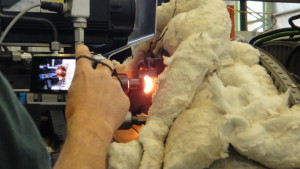 The exposure of large engineering structures to thermal and pressure stresses causes slow degradation over time through a metallurgical process known as creep. Creep deteriorates the structural integrity of the material and may cause structural and functional failure. Samples to determine the lifetime of plant components are currently taken from the surface of the component or from a piece removed from the component. Surface samples do not provide a representative sample and the removal of pieces often weaken the structure further. The Weldcore® process provides a depth sample and the repair is stronger than the original component. The sample and repair can be done by a single machine in situ with little downtime of the plant.
The exposure of large engineering structures to thermal and pressure stresses causes slow degradation over time through a metallurgical process known as creep. Creep deteriorates the structural integrity of the material and may cause structural and functional failure. Samples to determine the lifetime of plant components are currently taken from the surface of the component or from a piece removed from the component. Surface samples do not provide a representative sample and the removal of pieces often weaken the structure further. The Weldcore® process provides a depth sample and the repair is stronger than the original component. The sample and repair can be done by a single machine in situ with little downtime of the plant.
- Sampling using the Weldcore® process can provide information that will reduce the risk of unexpected catastrophic failure, reduce plant down time for full sampling, and provide an accurate indication as to whether the replacement of components can be delayed. These factors can lead to substantial cost savings as well as improved safety records.
- The in situ extraction of a metal- lurgical sample from the subject structure with limited down-time;
- Repair of the sample removal site with limited heating of the area thus maintaining the structural integrity of the component;
- Frequent sampling and analysis of the structural material allowing finer management of the lifetime of the structure;
- The extracted sample provides an actual depth profile of the material rather than a sample analysis extrapolation; and
- Other applications such as repairs of large castings, general void reparation during manufacture, crack repair in pipes and other high value structures, and welding of structural studs (connection points).
